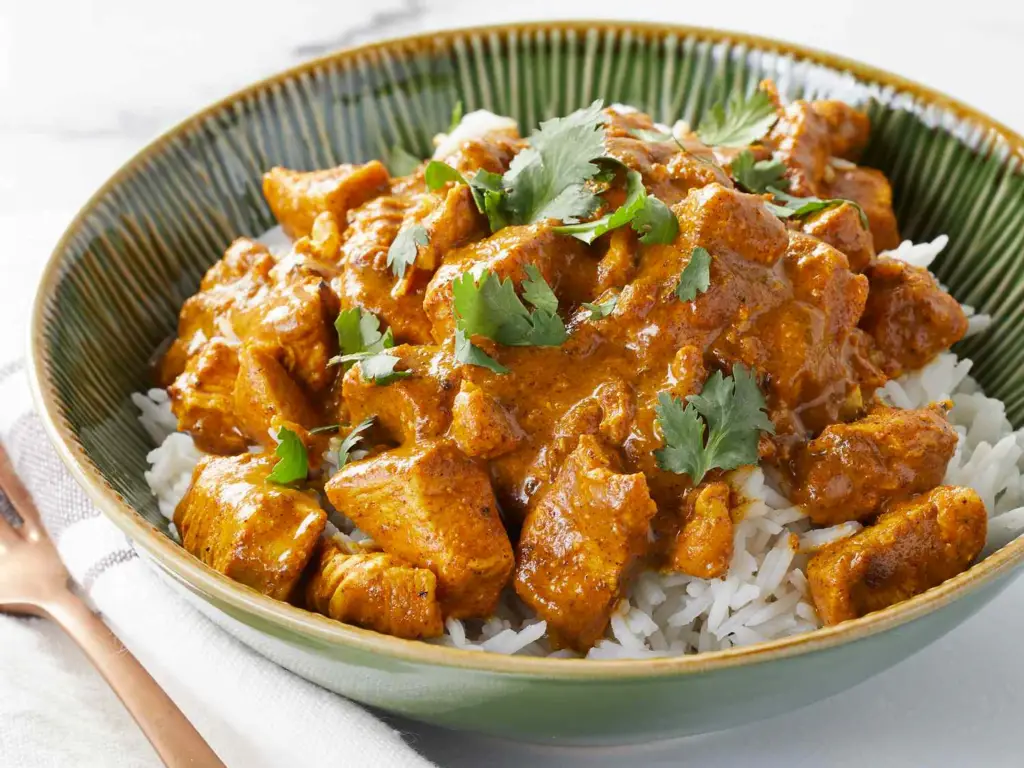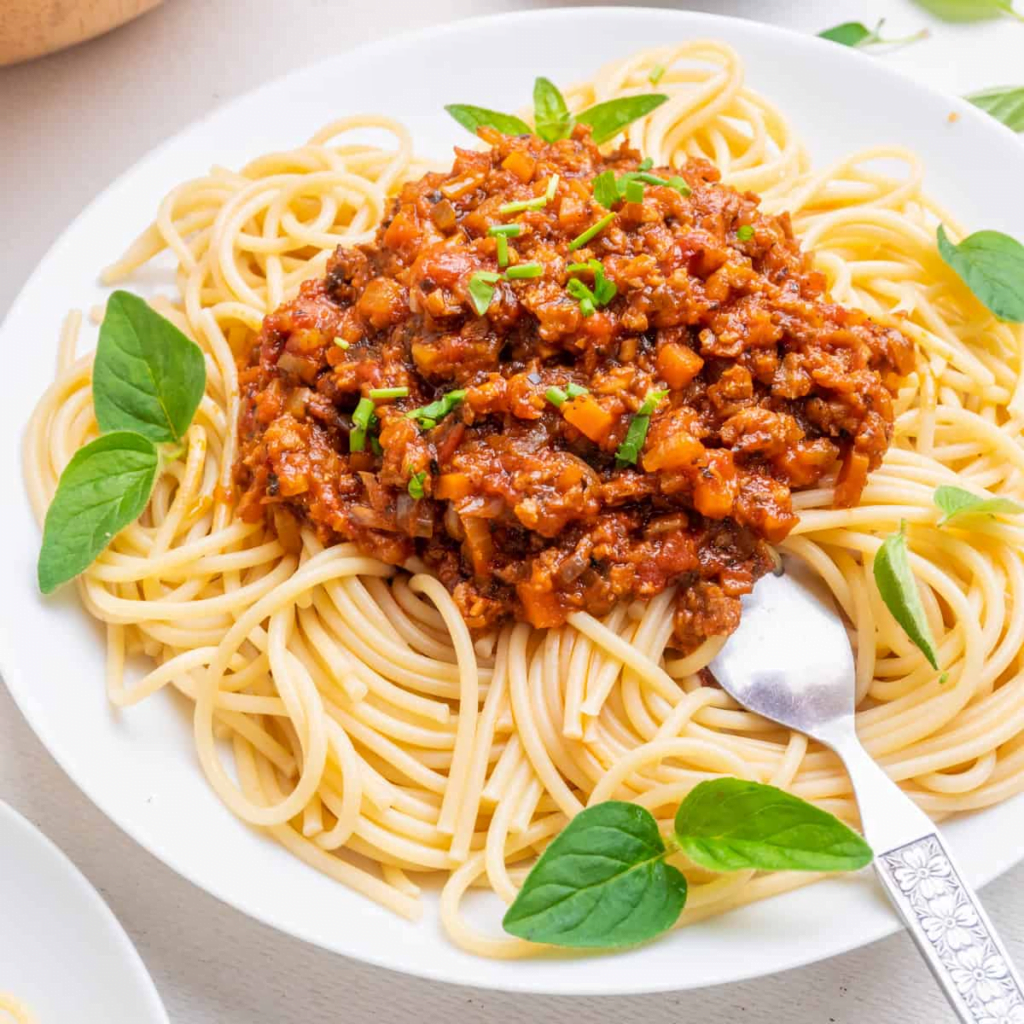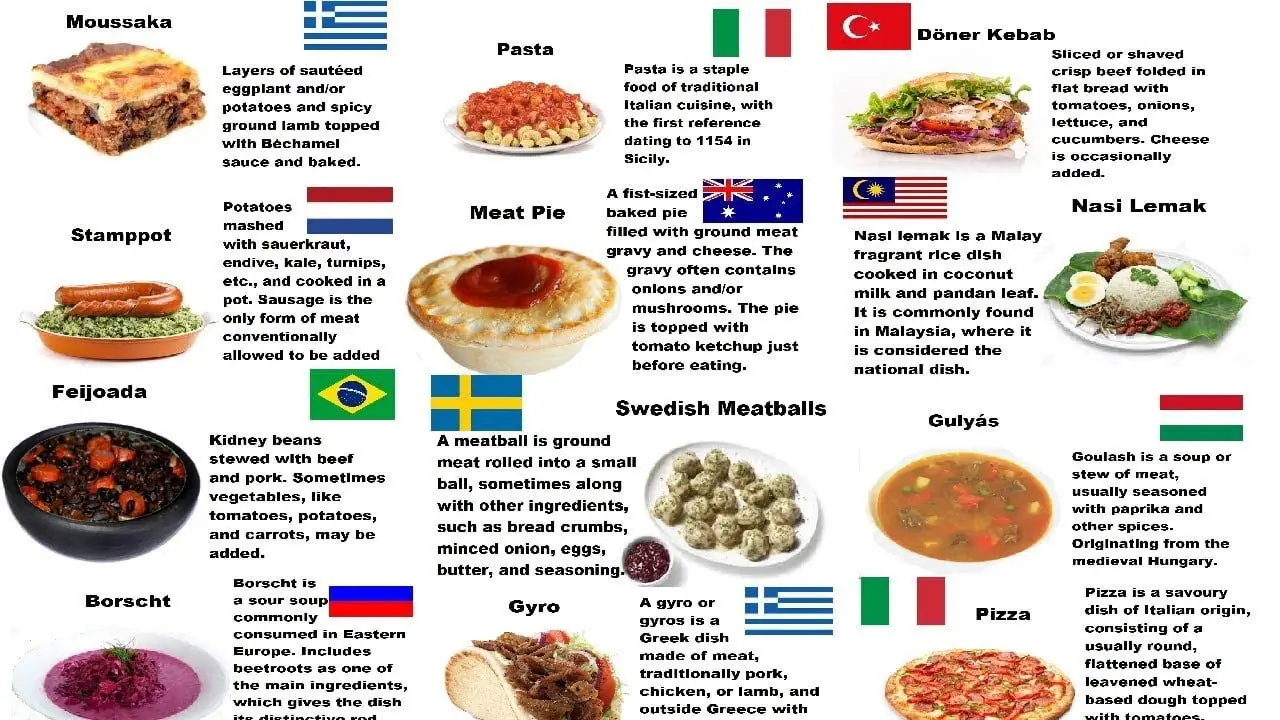In this culinary journey, we explore the most asked questions about national food dishes, diving into the traditions, significance, and variations that make each dish a cultural treasure. From the traditional dishes of Italy and Japan to the rich mole of Mexico and the spicy kimchi of Korea, each country’s culinary identity is a reflection of its history, geography, and cultural heritage.
What is the National Dish of Italy, and How is it Prepared?

Italy, known for its culinary excellence, boasts a traditional dish that has captured hearts worldwide. The traditional dish of Italy is Pasta alla Bolognese. This delectable creation originates from Bologna and features a slow-cooked meat sauce paired with perfectly cooked pasta. Here’s a detailed look at its preparation:
National Dish of Italy – Pasta alla Bolognese Ingredients
- Ground beef and pork
- Tomatoes
- Aromatic herbs
- Pasta of choice (commonly tagliatelle or pappardelle)
Pasta alla Bolognese Preparation Steps
- Sautéing: Brown the ground beef and pork in a pan.
- Simmering: Combine tomatoes, aromatic herbs, and the sautéed meat, allowing the flavors to meld through slow cooking.
- Cooking Pasta: Prepare the pasta separately until al dente.
- Combining: Serve the rich meat sauce over the perfectly cooked pasta.
This classic dish represents the heartiness and depth of flavor that defines Italian cuisine.
Check out the recipe – Click here
What is the National Dish of Japan, and How is it Prepared?

Japan’s culinary heritage shines through its traditional dish, Sushi. This iconic creation involves the artful combination of vinegared rice with various ingredients. Let’s explore how it’s prepared:
Sushi Varieties:
- Nigiri: Hand-pressed sushi with a topping, usually seafood.
- Sashimi: Thinly sliced raw fish or seafood served without rice.
- Maki: Rolled sushi with rice and ingredients wrapped in seaweed.
Preparation Process:
- Rice Preparation: Season rice with vinegar, sugar, and salt.
- Selection of Ingredients: Choose fresh seafood, vegetables, or other toppings.
- Assembling: Place the ingredients over the rice, using seaweed for rolls.
- Cutting: Slice into bite-sized pieces for serving.
Sushi is not just a dish; it’s a cultural expression, showcasing Japan’s dedication to precision and balance.
Check out the recipe – Click here
What Makes Mole the National Dish of Mexico?

Mexico’s national dish, Mole, holds a special place in the country’s culinary landscape. This rich, flavorful sauce comes in various types, such as mole poblano and mole negro. The complexity of its ingredients and preparation makes it a cultural icon:
Key Ingredients:
- Chocolate
- Chili peppers
- Nuts and seeds
- Spices
Preparation:
- Roasting: Toast the chili peppers, nuts, and seeds for depth of flavor.
- Blending: Grind the roasted ingredients into a paste.
- Cooking: Simmer the paste with chocolate and additional spices until it thickens into a rich sauce.
Mole represents the fusion of indigenous and Spanish ingredients, making it a symbol of Mexico’s cultural diversity.
Check out the recipe – Click here
What is the Significance the National Dish – Kimchi in Korean Cuisine?

Korea’s national dish, Kimchi, is more than just a side dish – it’s a cultural cornerstone. This fermented vegetable medley, typically made with Napa cabbage and Korean radishes, holds great significance:
Fermentation Process:
- Salting: Cabbage is salted to draw out excess water.
- Seasoning: Create a paste with garlic, ginger, chili peppers, and other seasonings.
- Coating: Coat the vegetables with the paste and pack them tightly into jars.
- Fermentation: Allow the mixture to ferment, developing its signature tangy flavor.
Kimchi is not only a staple in Korean homes but also a symbol of the country’s resilience and adaptability.
Check out the recipe – Click here
What is the National Dish of India, and Why is it Significant?

India’s national dish, Chicken Curry, is a testament to the country’s love for spices and vibrant flavors. This aromatic and flavorful dish features chicken cooked in a curry sauce made from a blend of spices, tomatoes, and onions.
Spice Blend:
- Cumin
- Coriander
- Turmeric
- Garam masala
Significance:
- Culinary Heritage: Chicken Curry reflects India’s rich spice blend, showcasing the diversity of regional flavors.
- Celebration of Ingredients: The dish celebrates the abundance of spices and local produce.
Check out the recipe – Click here
Are There Variations of Each Countries’ National Dish in Different Regions?
Yes, variations of national dishes exist across different regions of each country, showcasing the diversity of culinary traditions. In Italy, for example, pasta dishes vary from region to region, each highlighting local ingredients and preferences.
Similarly, Japan’s regional specialties, such as Osaka’s okonomiyaki and Hokkaido’s seafood-centric cuisine, add depth to the nation’s culinary landscape.
Are There Any Specific Customs or Traditions Associated with the Consumption of Each National Dish in Each Country?

The consumption of national dishes is often intertwined with customs and traditions that reflect the cultural values of each country.
In Italy, meals are a time for family and community bonding, with pasta dishes often served as a centerpiece during gatherings.
In Japan, sushi is not just a meal but an art form, with traditional customs like using hands for certain types of sushi.
Are There Vegetarian or Vegan Alternatives to the Traditional National Dish of Each Country?

Yes, many countries offer vegetarian or vegan alternatives to their traditional national dishes, catering to diverse dietary preferences.
In Italy, for instance, vegetarian lasagna substitutes meat with layers of flavorful vegetables and plant-based proteins. Japan offers vegetarian sushi options, replacing fish with ingredients like avocado, cucumber, and tofu.
Are There Any Annual Festivals or Events Dedicated to Celebrating the National Dish in Each Country?
In several countries, annual festivals or events celebrate their national dishes, providing an opportunity for locals and visitors alike to indulge in culinary delights.
Italy’s Pasta Festival, Japan’s Sushi Day, and India’s Curry Festival are just a few examples that showcase the cultural significance of these dishes and the joy they bring to people.
Table Summary
| Country | National Dish | Key Ingredients | Preparation Technique |
|---|---|---|---|
| Italy | Pasta alla Bolognese | Beef, pork, tomatoes, herbs, pasta | Slow-cooking, simmering |
| Japan | Sushi | Rice, seafood, vegetables, seaweed | Various, including rolling |
| Mexico | Mole | Chocolate, chili peppers, nuts | Roasting, blending, simmering |
| Korea | Kimchi | Cabbage, radishes, garlic, chili | Salting, seasoning, fermentation |
| India | Chicken Curry | Chicken, spices, tomatoes, onions | Spice blending, slow-cooking |
Frequently Asked Questions (FAQ)
1. What is the most iconic National Dish in Italy?
Italy’s most iconic dish is Pasta alla Bolognese, a delectable combination of slow-cooked meat sauce and perfectly cooked pasta.
2. Why is Sushi considered Japan’s National Dish?
Sushi represents Japan’s dedication to precision and balance, showcasing a variety of flavors and textures through its different forms like Nigiri, Sashimi, and Maki.
3. What makes Mole the National Dish of Mexico?
Mole is considered Mexico’s national dish due to its rich history, complex flavors, and the cultural fusion of indigenous and Spanish ingredients.
4. What is the significance of Kimchi in Korean cuisine?
Kimchi holds great significance in Korean cuisine, symbolizing resilience and adaptability, and is a staple in Korean homes.
5. What is the National Dish of India, and why is it significant?
India’s national dish is Chicken Curry, significant for its aromatic spices and celebration of the country’s diverse culinary heritage.
6. Are there variations of these countries’ National Dish in different regions?
Yes, variations exist across regions, adding depth to each country’s culinary landscape and reflecting local preferences and ingredients.
7. Are there any specific customs or traditions associated with the consumption of the National Dish in each country?
Yes, each country has specific customs and traditions associated with the consumption of their national dishes, often reflecting cultural values and familial bonding.

